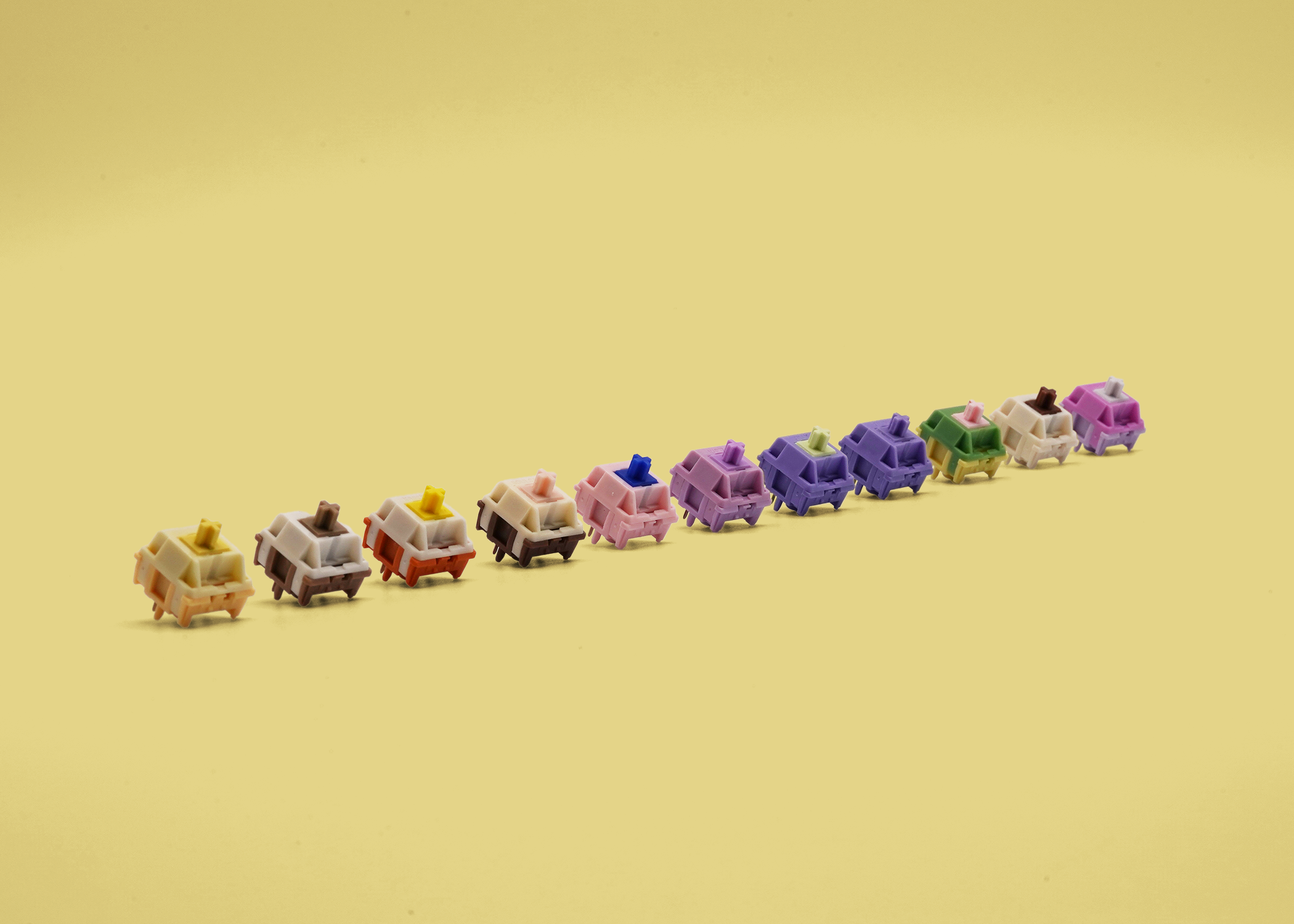Overview
In the ever-evolving world of mechanical keyboards, 2024 has already proven to be a groundbreaking year, with one name on everyone's lips — HMX switches.

From their ultra-smooth feel right out of the box to the minimal stem and housing wobble, HMX switches have taken the community by storm, setting new standards in performance and smoothness. But do they truly live up to the hype? In this in-depth review, we’ll dive into what makes these switches so special, comparing the similarities and differences among the most popular HMX switches. Let's dive into it!

Why HMX Switches?
The most obvious reason is their bang for the buck. HMX switches are priced much cheaper than some popular switches, like the Everglide Aqua King and the Gateron Ink V2, but their build quality and sound quality punch way above their price point. Even in their stock form with factory lube, HMX switches sound amazing without spring ping and feel buttery smooth without rattle or wobble, making them one of the best options for both beginners entering the hobby and for seasoned enthusiasts. HMX switches make us wonder what factors set cheap switches apart from expensive switches, challenging the industry to compete with their price to performance ratio.
The combinations of materials that HMX experiments with provides us with a variety of options without sacrificing feel or sound. Most of the earlier HMX switches have been made with a PC or nylon top housing, a POM or LY stem, and a nylon bottom housing which created relatively high-pitched and clacky sounding switches. Recently HMX has been experimenting with new materials, like T3 and T5 for their stem, creating some lower pitched and relatively thocky switches for HMX switches.
HMX Switches Covered
Now, we will talk about the following HMX switches:
- HMX Violet
- HMX Cheese
- HMX Xinhai
- HMX Poro
- HMX Sunset Gleam
- HMX Emo
- HMX Lotus
- HMX Hyacinth V2
- HMX Hyacinth V2U
- HMX YG Macchiato
- HMX Caramel Pudding
- HMX Hibiscus
- HMX SU

Switch Sound
We ranked these HMX switches from our perspective to provide a point of view for you to compare with.
From our perspective, here are the HMX switches in our catalog ranked from the most low-pitched or "thocky to the most high-pitched or "clacky" sound profiles:

Here are some sound tests:
Most of the HMX switches have a "clacky" sound signature (with the HMX Cheese, HMX Sunset Gleam, and the HMX Xinhai standing out as some of the more notable high-pitched HMX switches). There are a few HMX switches that sound relatively deeper or "thocky" in comparison to the rest of the HMX switches, (like the HMX Caramel Pudding, HMX SU, and the HMX Hibiscus) but in general they still lean towards a higher pitch relative to other switches in the market.
HMX switches sound crisp, clean, and clear to type on. The plastics used in HMX switches allows them to have a crisp bottom out while also having a poppy top out. The housing tolerances and stem wobble tolerances of HMX switches creates a clean sound void of any plastic-on-plastic rattle. The HMX factory lube replicates the effects of hand lubed switches which ends up producing a clear typing sound without any spring ping or leaf ping.
As for the volume, most HMX switches, typically the HMX switches with longer stem poles and shorter travel distances, are on the louder end of the spectrum. HMX switches aren't obnoxiously loud, nor would they create a disturbance in the workplace, but they are louder than your average switch. There are also options if you prefer to have a relatively softer volume, like the HMX Macchiato and the HMX Hyacinth V2U (which have a more normal full travel distance) or the HMX Hibiscus and HMX Caramel Pudding (which have a relatively deeper and softer bottom out). If you enjoy a lively keyboard configuration, then HMX switches would be a great option to try in your next build.
Switch Feel
HMX has done an amazing job manufacturing switches that both feel and sound great with their application of factory lube. For those of you that have tried HMX switches before, it has become well known that most, if not all, of the HMX switches have the same consistent smoothness right out of the box. And for those of us that haven't tried HMX switches before, HMX switches have arguably set the standard for factory lubed switches that do not require any mods but could still benefit from hand lubing or filming based on personal preference.
In addition to the smoothness, HMX manufactured switches have little to no stem wobble. Another reason I would describe HMX switches as "crisp" or "clean" is because of its lack of stem wobble and incredible tolerances. Typing on HMX switches enables typists to hear the pure sound of their configuration. The typing experience feels uninterrupted by any unnecessary wobble or chatter that might occur if there were noticeable stem wobble. But some enthusiasts might enjoy the flexibility that comes with some stem wobble, so like many other things in the hobby, it comes down to personal preference.
Most HMX switches have long stem poles and short travel distances compared to the normal 4.0 mm travel distance. Although there are a few full travel HMX switches, like the HMX Macchiato, for enthusiasts who want to experience HMX switches but prefer a full travel keypress.
Here is an illustration comparing the varying travel distances of HMX switches:

Here is an illustration comparing the varying spring weights of HMX switches:

Things to Note
Sound Profile
HMX switches tend to lean towards a higher pitch and brighter sounding sound profile (with some of their switches leaning slightly towards a deeper sound profile, like the HMX Caramel Pudding, the HMX SU, or the HMX Hibiscus, relative to the rest of their switches).
Spring Weight
HMX switches also tend to have a lighter spring weight and therefore requires less force to bottom out. For enthusiasts who prefer a heavier spring weight and a heavier bottom out, most HMX might feel light to type on in comparison to heavier switches, although there are a few options for heavier HMX switches like the HMX Xinhai which has an option for a 62.5g bottom out force version.
Switch Feel
HMX switches tend to have the same buttery smooth typing feel, but there are also enthusiasts who like to feel some texture while typing. For example, enthusiasts who prefer the Cherry scratch might not enjoy HMX switches as much, whereas enthusiasts who prefer gliding through their keypresses might particularly enjoy HMX switches more.
Switch Fit on Plate
One particular thing to note about HMX switches is that they tend to fit a little less tight onto the plate relative some other switches, like Cherry switches. The reason for this is the switch latching point on the switch has a different design from other cherry style switches, the top of the latching point is actually sloped allowing you to pull the switch out without pressing in the latch from the side with a switch puller. It's certainly an interesting design choice as it makes changing switches much easier, while still providing a stable hold onto the PCB. The biggest difference apart from ease of changing switches is that the switch might come out with the keycaps during keycap switches.
In one way this could be convenient for enthusiasts who like to swap their switches from time to time since they are easier to remove and require less strength. But for enthusiasts who like plate-less, half-plate, or just solder builds in general, HMX switches require a little more attention to make sure they are flush against the PCB since there is a possibility that the switches might move out of plate from flipping the PCB to solder.
Pin Design
The pins in HMX switches are also shaped slightly different than other switches. One of their pins has a wavy design rather than the typical straight edged pins. I am unsure why HMX chose this pin design, but I have noticed that HMX switches tend to make better contact with the hotswap contact points. Even for some keyboards that have been through excessive switch swaps to the point where the hotswap contact points are bent or pushed out, HMX switch pins still make solid contact to register keypresses where some other switches have failed to do so.
Switch Pricing
Here is an illustration comparing the differences in pricing among HMX switches:

HMX switches are almost a no brainer if you are looking for a great stock experience that requires no additional mods. It is up to personal preference depending on the sound signature, weight, and even smoothness/scratchiness. But one thing that is objectively true is that the ratio of their build quality to their price point make them one of the most competitive switches in the market.
If you have any questions or comments, please feel free to leave them below. We’d love to hear your feedback and how you like these HMX switches.
Other Reading
HMX Violet and JWK WOB | Rainy75 Switch Review
Holy Panda Tactile Switch Review
Gazzew Boba U4T Tactile Switch Review
Sarokeys Strawberry Wine V2 Linear Switch Review
HMX Cheese Linear Switch Review
HMX Macchiato Linear Switch Review
Cherry MX Black Clear Top "Nixie" Linear Switch Review
Durock Silent Switches Review | Dolphin, Shrimp, Daybreak Silent Switches
Gateron North Pole Linear Switch (Yellow and Red) Review
Video Sound Test: Expensive vs Cheap switches on QK65 R2 - Worth it?


Share:
Gateron Magnetic Jade vs Wuque WS Dash HE
Gateron Magnetic Jade vs Gateron KS-37B Magnetic FOX